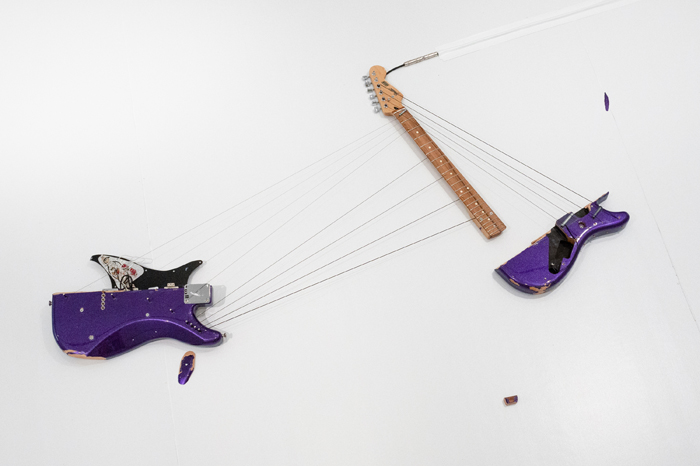
Naama Tsabar
Breaks and Suspensions
February 15 – March 25
Opening Reception: Friday, February 17, 5–8pm
Shulamit Nazarian is pleased to announce Breaks and Suspensions, an exhibition by Israeli-born, New York- based artist Naama Tsabar. This exhibition marks the artist’s second solo show with the gallery, on view from February 15 through March 25, 2023.
The exhibition title, Breaks and Suspensions, references colloquial terms for two of the artist’s ongoing series: Melody of Certain Damage and Gaffer. This exhibition marks the first time that these two series are exclusively shown together, making clear the conceptual and utilitarian connections shared by each body of work.
Tsabar’s practice fuses elements from sculpture, music, performance and architecture. Collaborating with local communities of female identifying and gender non-conforming performers, Tsabar writes a new feminist and queer history of mastery. Her interactive works expose hidden spaces and systems, reconceive gendered narratives, and shift the passive viewing experience to one of active participation. The artist draws attention to the muted and unseen by propagating sound through space and sculptural form. Resting someplace between sculpture and instrument, form and sound, Tsabar’s work lingers on the intimate, sensual, and corporeal potentials within these transitional states.
Tsabar’s Melody of Certain Damage series subverts the hypermasculine, destructive and cathartic action of smashing a guitar on stage by re-thinking the broken pieces back into a functioning object, bringing the sculptural into the realm of the aural and tactile. Beginning alone in her studio, Tsabar breaks the guitar against her floor. After impact and break, she maps the exact location of each scattered piece and then reconstructs the instrument so that it can once again emit sound. The resulting form of each work from this series operates as an artifact of the studio-based action, while allowing the new instrument to shift into the realm of sonic sculpture. Tsabar’s use of ready-made objects and the significant role of chance in Melody of Certain Damage introduces a dialogue with Dada practices of the early-twentieth century—a canonic period of art history now scrutinized for its preferential treatment toward male artists and its exclusion of their female contemporaries. Her works in this series are exhibited on low lying plinths on the gallery floor, just as one might find them scattered on a stage or in the artist’s studio. Rather than positioning the viewer solely as spectator, Tsabar opens the possibility to activate the artwork through touch. Viewers and performers can rest their bodies on the floor, beside the object, allowing their touch to elicit an emotional and sensual experience, as well as a sonic expression.
In her newest works from the ongoing Gaffer series, instrument cables travel through fields made from layering numerous strips of tape, the same material used to mask and stabilize cables in performance spaces. The monochromatic field of tape holds the cables suspended in different visual compositions as they flow in and out of the rectangular frame. In these works, Tsabar continues her interest in gaffer tape as a hidden utilitarian material within a performative order—a material she first used in her works Twilight (Gaffer Wall), 2006 and Encore, 2007. This series, which both critiques and pays homage to the aesthetics of Minimalism, moves the tape from the unseen location of the stage floor to its scrutable position on the gallery wall. Tsabar specifically calls attention to the hidden labor associated with the material through the meticulous layering of the tape, creating a significant thickness and a subtle textural rhythm of lines on its surface. She further calls attention to the labor involved in their creation by naming the people who contributed to the act of “gaffering” in the credit lines of the work. These artworks refuse to be confined to a single category, borrowing from elements of painting, drawing, and sculpture. They hinge the functional and the visual; while the cable running through the work can be read as a gestural mark, and the tape itself a color field, the works never lose their potential to actively transmit sound.
Within the exhibition, works from each series are not only united by their concept, at times they also become physically linked. Audio cables transmit sound from the broken guitars in Melody of Certain Damage, move through the physical plane of the Gaffer works, and ultimately connect to a live amplifier that emits sound throughout the gallery. With this gesture, Tsabar activates each artwork and the gallery itself, turning the viewer, artwork, and architecture into active collaborators.
Throughout these works, Tsabar’s invocation of Dada and Minimalist processes and aesthetics is not only an act of feminist reclamation, it also highlights the influences within liberatory movements: Dada’s anti-war anarchic absurdism, Minimalism’s socialist use of industrial objects to create material accessibility, and both movements’ rejection of institutional spaces. Citing these approaches within her work, Tsabar’s practice goes beyond revising art history to diversify the canon. It harnesses these elements as part of a modus operandi that is feminist and a practice that positions individual viewers and local communities as direct participants.

